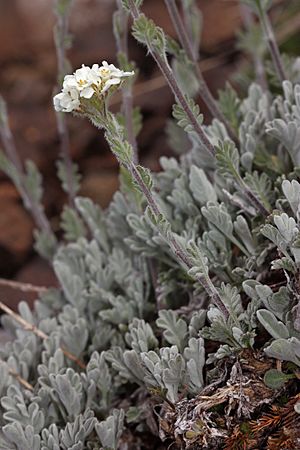Alpine smelowskia facts for kids
Quick facts for kids Alpine smelowskia |
|
|---|---|
 |
|
| Scientific classification | |
| Genus: |
Smelowskia
|
| Species: |
americana
|
Smelowskia americana is a cool little plant. It's also known as alpine smelowskia, Siberian smelowskia, or American false candytuft. This plant is part of the Smelowskia family.
You can find it growing in the mountains of western North America. This includes places like the Olympic Mountains and Cascade Range in Washington. It also grows in the Rocky Mountains in British Columbia and Alberta, stretching south to Colorado. This plant loves rocky areas and steep slopes high up in the mountains. It usually grows at elevations from 1,300 to 4,000 meters (about 4,200 to 13,000 feet). Its pretty flowers bloom from late May until early September.
What it Looks Like
This plant is a perennial herb, which means it lives for more than two years. It grows from underground stems called rhizomes. It often forms a grayish-green mat on the ground. Its stems can be a bit hairy and grow from about 1.5 centimeters (half an inch) to 20 centimeters (about 8 inches) tall.
The leaves at the base of the plant are shaped like an egg or a reversed egg. They are usually between 0.4 and 10 centimeters (0.15 to 4 inches) long. They are also about 1 to 15 millimeters (0.04 to 0.6 inches) wide. These leaves can be smooth-edged or have deep lobes, like a feather. They grow on stalks called petioles that are about as long as the leaf itself. The leaves on the flower stem are smaller and grow in an alternating pattern.
Each plant usually has one flower head on a thin stem that stands upright or leans slightly. The flowers have four white petals, but sometimes they can be light purple. These petals are about 4 to 8 millimeters (0.15 to 0.3 inches) long. Each flower also has six stamens, which are the parts that hold the pollen, with yellow tips.
How it Spread Over Time
Scientists studied the history of the Smelowskia plant group in 2010. They looked at the plant's DNA to understand how it evolved. They found that the Smelowskia group first appeared in Central Asia.
From Central Asia, these plants spread to North America. They crossed over a land bridge called Beringia. This land bridge used to connect Asia and North America. This happened in two separate events. Smelowskia americana, along with S. porsildii and S. media, are the result of one of these journeys.
- S. porsildii is found in the Beringia region.
- S. media grows in the western Arctic parts of North America.
- S. americana is the most widespread of the three. It's found in the middle-latitude mountains of western North America.
These three areas were not covered by ice during the Last Glacial Maximum. This was a very cold period about 25,000 to 21,000 years ago. Because these areas were ice-free, the plants could survive there. This might have led to new species forming in these safe places, called refugia, during the ice age.

